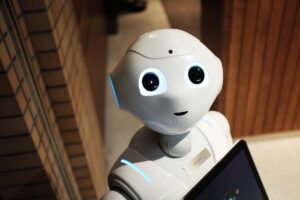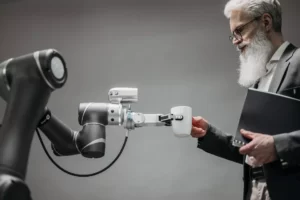Dive into the ‘Artificial Intelligence vs. Machine Learning’ realm, exploring their revolutionary impact on industries. In this article, we will explore the differences between these two innovative technologies and how they are revolutionizing various industries. So, let’s dive in!
In the Artificial Intelligence vs. Machine Learning comparison, AI stands for the broader concept of empowering machines to perform tasks that would normally require human intelligence. In the Artificial Intelligence vs. Machine Learning spectrum, AI encompasses applications like speech recognition and decision making.
In a Nutshell
- In the Artificial Intelligence vs. machine learning context, AI is the overarching concept, while machine learning (ML) is a subset of AI focused on training machines to learn from data and improve over time.
- In the Artificial Intelligence vs. Machine Learning dialogue, AI spans several technologies, whereas ML specifically employs algorithms for pattern identification.
- In Artificial Intelligence vs. Machine Learning, ML leans on data for training models, while AI integrates techniques like NLP and robotics.
- AI aims to simulate human intelligence, including capabilities such as reasoning, problem solving, perception and learning, while ML focuses on data driven capabilities.
- In AI, the goal is usually to replicate or exceed human performance, while ML focuses on solving specific tasks or making accurate predictions.
- AI and ML are not mutually exclusive; ML methods are commonly used in AI systems to enable learning and adaptation.
- Both AI and ML have great potential in a wide range of applications, such as healthcare, finance, transportation, or customer service, among others.
- When delving into Artificial Intelligence vs. Machine Learning, ethical considerations in developing these systems are vital, including issues related to privacy, bias, transparency, accountability, and impact on employment and society.
- In the evolving narrative of Artificial Intelligence vs. Machine Learning, AI’s field is rapidly advancing, shaping future directions.
- Understanding the differences and opportunities presented by AI and ML can help individuals and organizations leverage their potential for innovation and problem solving.
Conversely, in Artificial Intelligence vs. Machine Learning, ML represents a subset of AI, focusing on, focusing on the ability of computers to learn and improve from experience without explicit programming. ML algorithms use historical data to identify patterns and make predictions or decisions without being explicitly programmed for a specific task. It allows machines to learn and adapt without human intervention.
Although AI is the overarching concept, machine learning plays a key role in achieving AI capabilities. ML algorithms drive many AI applications, enabling machines to learn from data and improve their performance over time.
Artificial intelligence is the science of making machines do things that would require intelligence if done by men.
Marvin Minsky
A key distinction in Artificial Intelligence vs. Machine Learning lies in their scope and application. AI is a broader concept that encompasses several technologies, while ML is a specific focus within the AI landscape. AI not only includes ML, but also incorporates other branches such as natural language processing, computer vision and robotics.
In conclusion, within Artificial Intelligence vs. Machine Learning, these are interconnected yet distinct. AI represents the broader idea of endowing machines with human like intelligence, while ML is a specific technique that enables machines to learn and improve from data. Both AI and ML are driving significant advances in various sectors, shaping the future of technology and innovation.
Definition and History
In the Artificial Intelligence vs. Machine Learning narrative, these two terms refer to different concepts within the field of technology. In this section, we will define and explore the history of AI and ML, highlighting the distinctions between them.
Artificial Intelligence is a broad term that encompasses the development of computer systems capable of performing tasks that normally require human intelligence. These tasks include speech recognition, decision making, problem solving, and so on. Its goal is to create machines that can think and reason like humans, making them capable of learning from experience and adapting to new situations.
Machine learning, on the other hand, is a subset of AI that focuses on the development of algorithms and statistical models. It allows computers to learn and improve their performance on a specific task without being explicitly programmed. In essence, ML allows machines to automatically analyze and interpret large data sets, identify patterns and make predictions or decisions based on those patterns.
The origins of AI date back to the 1950s, when scientists began to envision the possibility of creating machines that could mimic human intelligence. The term “artificial intelligence” was coined in 1956, during a conference at Dartmouth College.
Machine learning, however, came into prominence later, with the advancement of computing power and the availability of large data sets needed to train algorithms. In recent years, machine learning has experienced significant growth, driven by advances in areas such as deep learning and neural networks.
In short, AI and ML are closely related but distinct concepts. AI aims to create machines that can think and reason like humans, while ML focuses on developing algorithms that enable machines to learn and improve their performance on specific tasks. Understanding these differences is essential to understanding the advances and implications of these technologies in various industries.
In Depth Look at Artificial Intelligence vs. Machine Learning
Artificial intelligence and machine learning are two terms that are often used interchangeably, but they are not the same.
Understanding the key differences between artificial intelligence (AI) and machine learning (ML) is crucial to understanding how these technologies are shaping the world around us.
AI refers to the broader concept of creating machines or systems that can perform tasks that normally require human intelligence. It encompasses a wide range of capabilities, such as speech recognition, decision making, problem solving and natural language processing. The goal of AI is to simulate human intelligence in machines to perform tasks more efficiently and accurately.
On the other hand, ML is a subset of AI that focuses on the ability of machines to learn and improve from experience without explicit programming. Rather than being explicitly programmed, ML algorithms learn and adapt from data, allowing them to make predictions or take measurements based on patterns and trends found in large data sets. ML algorithms are very effective in tasks such as image recognition, language translation and personalized recommendations.
Although AI and ML are interconnected, the main difference lies in their scope and methodology. AI is a broad concept that encompasses several technologies, including ML. ML, on the other hand, is a specific approach within AI that enables machines to learn from data and improve their performance over time.
In short, AI is the broader concept of creating intelligent machines, while ML is a subset of AI that focuses on enabling machines to learn and improve from experience. By understanding these key differences, we can appreciate the unique capabilities and applications of each technology, as well as their combined potential to transform industries and improve our daily lives.
Practical Applications of Artificial Intelligence vs. Machine Learning
Practical Applications of Artificial Intelligence vs. Machine Learning have become powerful technologies with a wide range of practical applications in a variety of industries. This section will explore three prominent use cases for each of these technologies, namely healthcare, retail and autonomous vehicles for AI, and recommender systems, fraud detection and virtual personal assistants for ML.
Artificial Intelligence
- Healthcare: Within Artificial Intelligence vs. Machine Learning, AI revolutionizes healthcare by enhancing diagnostics, personalized medicine and patient care. AI algorithms can analyze large amounts of medical data, such as patient records, images, and genomic data, to identify patterns and make more accurate diagnoses. In addition, AI based robotic surgery systems improve accuracy and reduce surgical errors.
- Retail: In Artificial Intelligence vs. Machine Learning, AI transforms retail by enriching customer experiences and optimizing operations. Leading retailers are using AI algorithms to analyze customer data and provide personalized recommendations, enabling targeted marketing and increased sales. AI powered chatbots and virtual assistants also improve customer service by providing instant responses to queries, increasing engagement and improving customer satisfaction.
- Autonomous vehicles: The development of autonomous cars is a significant application of AI. These vehicles use AI based algorithms to perceive their environment, interpret road conditions, and make real time decisions. AI enables autonomous vehicles to navigate complex environments, improving road safety and efficiency. In addition, AI is used in optimization algorithms to minimize traffic congestion and improve transportation systems.
Machine learning
- Recommendation systems: Machine learning algorithms power recommendation systems that drive personalized product recommendations on e-commerce platforms and streaming services. These algorithms analyze user behavior, preferences, and historical data to accurately predict user preferences and make personalized recommendations. Recommender systems improve user experience, increase customer satisfaction, and contribute to increased sales and customer retention.
- Fraud detection: Machine learning plays a vital role in detecting and preventing fraudulent activities in various industries, including banking and online transactions. ML algorithms analyze historical data and identify patterns or anomalous behaviors that indicate potential fraud. By continuously learning from new data, ML models can adapt and improve fraud detection accuracy, protecting businesses and consumers from financial loss.
- Virtual personal assistants: Virtual personal assistants, such as Apple’s Siri and Amazon’s Alexa, rely on machine learning algorithms to understand and respond to the user’s voice commands. These AI powered assistants use natural language processing and speech recognition techniques to engage in human like conversations, respond to queries, and perform tasks. Machine learning enables virtual personal assistants to continuously improve their understanding and response accuracy over time.
In conclusion, AI and ML have found practical applications in a variety of sectors, benefiting industries such as healthcare, retail and transportation. With AI, we are seeing advances in diagnostics, customer experience and autonomous vehicles. ML, meanwhile, is showing its capabilities in personalized recommendations, fraud detection and virtual personal assistants. These technologies continue to evolve and offer great potential for innovation and improvement in all sectors.
Future Trends in Artificial Intelligence vs. Machine Learning
In discussing Artificial Intelligence vs. Machine Learning, it’s important to note that the two terms that are often used interchangeably, but have distinct differences and impacts on various industries. AI refers to the development of computer systems capable of performing tasks that would normally require human intelligence. On the other hand, machine learning is a subset of AI that focuses on enabling machines to learn from data and improve their performance over time.
AI has already made significant advances in sectors such as healthcare, finance and manufacturing. In the financial sector, AI is used to automate routine tasks, improve risk assessment and enhance fraud detection. It can quickly analyze large volumes of data, identify patterns and make more accurate predictions, ultimately improving decision making processes.
ML, meanwhile, has been primarily responsible for the growth of recommender systems, predictive analytics and personalized customer experiences. By analyzing large amounts of data, ML algorithms can identify trends, provide insights and make predictions about customer behavior, market trends and investment opportunities.
Future trends in AI and ML are promising. As technological advances continue, AI is expected to become even more sophisticated and capable of handling complex tasks. ML algorithms are also expected to improve, enabling organizations to leverage big data and gain more valuable insights. In addition, the integration of AI and ML with other emerging technologies such as blockchain and the Internet of Things (IoT) will open up new opportunities for innovation and automation.
While there is debate about the potential impact of AI and ML on jobs, these technologies are more likely to augment human capabilities rather than replace them entirely. By automating repetitive tasks, AI and ML free up time for professionals to focus on higher value work that requires critical thinking and creativity.
In conclusion, AI and ML are revolutionizing the financial industry and will continue to shape its future. Understanding the differences between AI and ML is essential for firms to harness the potential of these technologies effectively. With continued advances, organizations that embrace AI and ML will gain a competitive advantage in an increasingly data driven world.
Wrap Up
As we wrap up our exploration of Artificial Intelligence (AI) vs. Machine Learning (ML), we’ve delved deep into their definitions, histories, practical applications, and future trends. We’ve learned that AI, the broader concept, encompasses a range of technologies aimed at simulating human intelligence. Machine Learning, a critical subset of AI, focuses on training machines to learn from data, thereby improving their performance over time.
The practical applications of these technologies are vast and varied. In healthcare, AI aids in diagnostics and robotic surgery, while ML drives personalized medicine. In retail, AI enhances customer experiences and optimizes operations, whereas ML powers recommendation systems for a more personalized shopping experience. In transportation, AI is pivotal in developing autonomous vehicles, while ML contributes significantly to fraud detection and virtual personal assistants.
Looking ahead, the future of AI and ML is bright and full of potential. As these technologies evolve, they promise to bring more sophisticated solutions across various sectors, augmenting human capabilities and opening new frontiers for innovation. It’s clear that understanding the synergy and distinct functionalities of AI and ML is crucial for leveraging their full potential.
In conclusion, the narrative of Artificial Intelligence vs. Machine Learning is one of interconnectivity and distinction. While AI aims to replicate human intelligence in a broad sense, ML provides the tools for machines to learn from data, making them smarter over time. Their combined impact is revolutionizing industries, from healthcare to finance, and shaping the future of technology. The journey into AI and ML is not just about understanding machines but also about envisioning a future where technology and human intelligence work in harmony for a better world.
FAQs

Artificial intelligence (AI) is a broad field of computer science that aims to create machines capable of performing tasks that would normally require human intelligence. AI encompasses a variety of techniques, such as machine learning and deep learning, that enable computers to understand, reason, learn and make decisions.
Machine learning is a subset of AI that focuses on teaching computers to learn and improve from experience without being explicitly programmed. It involves developing algorithms and statistical models that allow machines to analyze large amounts of data, detect patterns and make predictions or decisions based on that information.
While artificial intelligence is a broader concept that encompasses the simulation of human intelligence, machine learning is a specific method by which AI systems can acquire knowledge and improve their performance. In other words, machine learning is one of the tools used in building artificial intelligence systems, along with other techniques such as natural language processing or computer vision.
Machine learning typically involves training a model on a large data set containing examples of the problem the system is intended to solve. By applying various algorithms to analyze the data and identify patterns, the model learns from these examples and becomes capable of making predictions or decisions when presented with new and unknown data.
Artificial intelligence and machine learning have numerous real world applications. They are used in areas such as speech recognition, image and object recognition, virtual assistants, recommender systems, fraud detection, autonomous vehicles, medical diagnostics, financial analysis and many more. These technologies have the potential to revolutionize industries and improve various aspects of our lives.
In the context of Artificial Intelligence vs. Machine Learning, modern businesses are integrating AI for broader strategic decision making, while ML is utilized for data driven insights and predictive analytics.
The future of Artificial Intelligence vs. Machine Learning is promising, with AI expected to evolve into more complex problem solving, while ML advances in precision and predictive capabilities.
In the Artificial Intelligence vs. Machine Learning discourse, while AI may automate some jobs, it also creates new roles, and ML enhances skills and productivity in various sectors.
Educational institutions are increasingly incorporating Artificial Intelligence vs. Machine Learning into curricula, preparing students for AI driven industries and ML specific roles.
In the Artificial Intelligence vs. Machine Learning comparison, AI impacts daily life through smart devices and automation, while ML enhances personalized experiences through data analysis.
In Artificial Intelligence vs. Machine Learning, while AI provides diagnostic support, ML aids in predictive analysis; however, human oversight remains crucial for critical healthcare decisions.
Small businesses can leverage Artificial Intelligence vs. Machine Learning for cost effective solutions, targeted marketing (via ML), and process automation (via AI).
Article sources
At Capital Maniacs, we are committed to providing accurate and reliable information on a wide range of financial topics. In order to achieve this, we rely on the use of primary sources and corroborated secondary sources to support the content of our articles.
Primary sources, such as financial statements and government reports, provide firsthand evidence of financial events and trends. By using primary sources, we are able to directly reference information provided by the organizations and individuals involved in these events.
Secondary sources, such as financial analysis and commentary, interpret and analyze primary sources. While these sources can be useful for providing context and background information, it is important to use corroborated sources in order to ensure the accuracy and reliability of the information we present.
We take pride in properly citing all of our sources, both primary and secondary, in order to give credit to the original authors and to allow our readers to verify the information for themselves. We appreciate your trust in our website and are committed to upholding the highest standards of financial journalism.
- Ai.engineering.columbia.edu – Artificial Intelligence (AI) vs. Machine Learning
- Cloud.google – AI vs. Machine Learning: How Do They Differ?
- Azure.microsoft – Artificial Intelligence vs. Machine Learning
- Coursera.org – Machine Learning vs. AI: Differences, Uses, and Benefits
- Aws.amazon – AI vs Machine Learning – Difference Between Artificial Intelligence and ML – AWS
- IBM – AI vs. Machine Learning vs. Deep Learning vs. Neural Networks: What’s the difference?
- Professionalprograms.mit.edu – Machine Learning vs Artificial Intelligence: What’s the Difference?

























